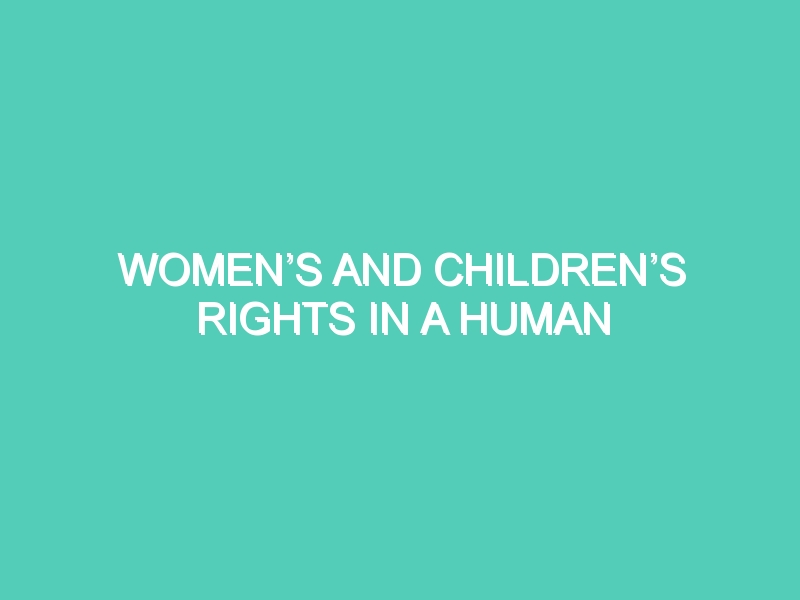Read the entire Paper on – https://www.unicef.org/gender/files/WomensAndChildrensRightsInAHumanRightsBasedApproach.pdf
Executive Summary
The paper examines the linkages between children’s and women’s rights in the context of the Convention on the Rights of the Child (CRC) and the Convention Against the Elimination of All Forms of Discrimination Against Women (CEDAW). The paper demonstrates how reading these conventions together can enrich the promotion and protection of children’s and women’s rights in three major ways. First, the provisions of the CRC and CEDAW overlap in many areas; thus, reading them together enables a more comprehensive human rights based approach that takes into account specific vulnerabilities based on both age and gender. Second, in some instances, one convention addresses an issue of concern to children or women where the other convention is silent. Third, in many instances, protection of women’s rights is important for the achievement of children’s rights and, conversely, protection of children’s rights is important for the achievement of women’s rights. Consequently, the two conventions are both mutually reinforcing and complementary. The first section of the paper provides an overview of human rights based approaches to development as a strategy for the advancement of children’s and women’s rights. Rights based approaches emphasize the obligations of duty bearers, primarily States but also UN agencies, and the entitlements of claims holders, including women and children. Rights based approaches use human rights norms to hold States Parties accountable for the realization of rights, rely on these norms as a guide for development work and for assessing programmatic impacts, and emphasize the importance of participation and empowerment of individuals and groups, particularly the most vulnerable among them. UNICEF’s policy documents since the 1990s have referred to the importance of programming to achieve children and women’s human rights. This approach was clarified by the 1994 policy statements on gender equality and women’s empowerment and the 1998 Executive Directives for Human Rights Based Programming Approach. The paper highlights aspects of the human rights based approach that are particularly relevant for the achievement of children’s and women’s rights. First, the achievement of civil and political rights is indivisible from the advancement of social, economic and cultural rights. Consequently, States have positive obligations to protect and fulfil both civil and political rights and economic, social and cultural rights through actions such as legal reforms and budgetary allocations. Additionally, human rights law has increasingly recognized the impact of multiple forms of discrimination, acknowledged violence against women as a human rights violation, and placed emphasis on women and children as rights holders. Norms are also being developed to hold non-State actors accountable for violations of the rights of women and children. The paper outlines essential elements of a human rights based approach to programming for women and children, including programming aimed at eliminating the disadvantages faced by women and children, prioritizing support to good governance, building capacity of duty bearers and rights holders, using gender-disaggregated data and analysis, and participating in and strengthening the work of the treaty bodies. The second section of the paper discusses more specifically the relevance and benefits of linking the CEDAW and CRC in the context of programming areas. A number of provisions of the CRC are of specific importance to the girl child, such as the requirement that States Parties take measures to abolish harmful traditional practices and the provision that States Parties protect i children from various forms of violence. The Committee on the Rights of the Child has been proactive in addressing gender in the context of children’s rights, including placing requirements of sex disaggregated data in country reporting guidelines, raising issues, questions and concluding comments specific to the girl child when considering States’ reports, and holding special sessions on issues related to the girl child. CEDAW contains several provisions specific to children, including emphasizing that the interests of the child are to be the paramount consideration in matters related to children’s upbringing and development and the requirement that States reduce female student dropout rates. Additionally, the CEDAW Committee adopted a General Recommendation requiring States to take measures to abolish female circumcision and frequently references the situation of the girl child in its concluding comments. CEDAW and the CRC should be viewed as complementary and reinforcing. When read together, the Conventions protect the rights of girls and women throughout their life cycles. The CRC provides that the rights protected apply equally to boys and girls and grants certain protections to women, such as pre- and post-natal care, education on the advantages of breastfeeding, and family planning education and services. The CEDAW is not age-specific. Both conventions provide protections for children and women inside the private sphere and prioritize the best interests of the child. Additionally, both conventions prohibit discrimination on the basis of sex and implicitly call for affirmative action policies or temporary special measures, such as preferential access to girls in education, in order to achieve substantive equality. The bulk of the second section of the paper focuses on specific programmatic areas, providing the relevant provisions of CRC and CEDAW for each area, examples of how the CRC and CEDAW have been linked in various countries, and concrete recommendations to further advance these linkages. Areas addressed include law reform, rights in the family, violence against women and children, health, HIV/AIDS, education, trafficking, and institution building and monitoring. For example, in the area of law reform, countries have passed Constitutional amendments to provide married women the right to pass their nationality to their children and guarantee the right of mothers to pre-natal care and maternity benefits. Additionally, countries have passed statutes that provide for a shared responsibility of mothers and fathers in child bearing and prohibit discrimination against women who bear girl children. Recommendations in the area of law reform include preferential access of girls to education in countries and regions where women have historically been disadvantaged, review of macro-economic policies that reinforce gendered notions of family and undermine a shared role in parenting, and analysis on the linkages between the problems facing women and children in various countries. The paper thus presents how the CRC and CEDAW can be linked to effective programming by States and international agencies to advance children’s and women’s rights globally. UN agencies can further this mission by supporting national governments in legislative, policy and budgetary reforms aimed at fulfilling their human rights obligations as well as building the capacity of civil society, particularly children and women, to secure their rights. Effective programming in this regard requires a human rights based approach that integrates gender analysis, participatory methods, and international human rights norms.



